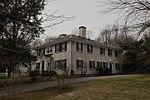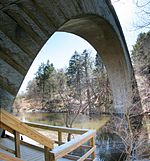John Woodward House
1686 establishments in the Massachusetts Bay ColonyColonial architecture in MassachusettsHouses completed in 1686Houses on the National Register of Historic Places in Newton, MassachusettsNewton, Massachusetts Registered Historic Place stubs

The John Woodward House is a historic house at 50 Fairlee Road in Newton, Massachusetts. Built sometime before 1686, it is one of the city's oldest surviving buildings. It is a 2+1⁄2-story timber-frame structure, with a large central chimney, and is four bays wide and one deep. Its front entry has sidelight windows that were probably added in the 19th century, and the entry is enclosed in a Colonial Revival portico. The house was for 275 years owned by the family of John Woodward, one of Newton's early settlers.The house was listed on the National Register of Historic Places in 1986.
Excerpt from the Wikipedia article John Woodward House (License: CC BY-SA 3.0, Authors, Images).John Woodward House
Fairlee Road, Newton Waban
Geographical coordinates (GPS) Address Nearby Places Show on map
Geographical coordinates (GPS)
| Latitude | Longitude |
|---|---|
| N 42.322638888889 ° | E -71.223333333333 ° |
Address
Fairlee Road 50
02468 Newton, Waban
Massachusetts, United States
Open on Google Maps










